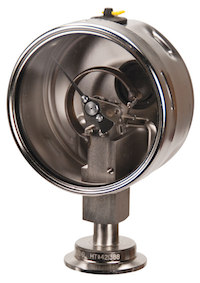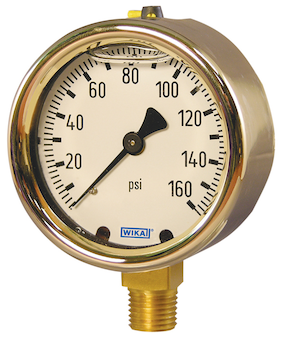
Among a wide variety of industrial pressure gauges used today, liquid-filled brass gauges are popular for their durability, precision, and low cost of ownership.

Inner working of a Bourdon tube pressure gauge
The mechanical Bourdon tube gauge is a time-tested instruments found in numerous industrial applications today, including in portable equipment like compressors, pumps, and hydraulic tools. WIKA’s model 213.40 Bourdon tube brass gauge utilizes and improves on this age-old technology. A solid piece of forged brass increases durability and minimizes leakage of the liquid case fill, which dampens pointer flutter and extends the instrument’s service life. The copper alloy also holds up well against mishandling or abuse, one of the causes of pressure gauge failure.
The Advantages of Liquid Gauges over Dry Gauges
While slightly more expensive than dry gauges, liquid-filled brass gauges are more economical in the long run because they are designed to withstand harsh conditions. Vibration, pulsation, humidity, temperature fluctuations, and other extreme conditions are hard on traditional dry gauges. The fluid in liquid-filled brass gauges effectively solves these issues by protecting the internals from the elements and reducing wear and tear. In the case of frequent pressure cycles (pulsations), WIKA recommends accessorizing the gauge with a restrictor or snubber in combination with the case filling.
The type of case filling varies depending on the application and operating conditions. Glycerin is suitable for most applications with non-oxidizing fluids, and this is the standard case filling for the 213.40 brass gauge. Silicone oil is typically used in low ambient temperatures down to −40°F/°C. For oxidizing fluids, inert liquids such as Halocarbon oil or Fluorolube® are good choices.

Model 213.40 brass gauge
WIKA’s Model 213.40 Bourdon Tube Brass Gauge
WIKA’s brass gauge has a solid forged-brass case and socket, and its liquid filling enables it to withstand most adverse conditions, including high vibration, shock, and pulsation. Known as “the hydraulic gauge” in the industry, model 213.40 is regularly used in mobile and stationary machinery, and many other heavy-duty hydraulic applications. Brass gauges are also extensively used in upstream oil & gas applications with pressure ranges of up to 15,000 psi. Our glycerin-filled brass gauges are virtually indestructible, making them the standard in oil fields.
The 213.40 was the first liquid-filled gauge introduced to the U.S., in the 1960s, and WIKA continues to be the sole U.S. manufacturer of this type of solid brass gauge. Over the years, overseas importers have copied numerous models of brass gauges and introduced them to the market, but the 213.40 remains unparalleled in its quality, durability, and low cost of ownership.
WIKA USA’s comprehensive portfolio of pressure instruments consist of a number of customizable mechanical gauges, including models that meet the demanding conditions of process industries. For more information on whether a brass gauge is the right choice for your application, contact our pressure specialists.

